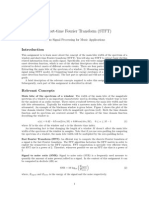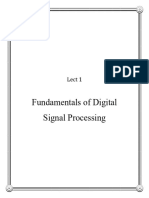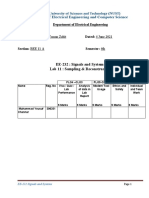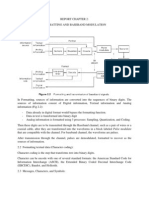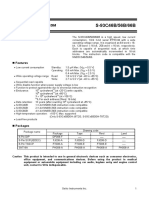Matlab Activity
Matlab Activity
Uploaded by
Tatsuya ShibaCopyright:
Available Formats
Matlab Activity
Matlab Activity
Uploaded by
Tatsuya ShibaOriginal Title
Copyright
Available Formats
Share this document
Did you find this document useful?
Is this content inappropriate?
Copyright:
Available Formats
Matlab Activity
Matlab Activity
Uploaded by
Tatsuya ShibaCopyright:
Available Formats
COURSE/SECTION: ECE011/EC22FB1
NAME: Deocadiz, Angelito B.
STUDENT NO: 1810910
ACTIVITY: Assignment
SCORE
DATE: 11/28/2019
PERIOD: Prelims/Midterms/Finals
Using matlab or octave. Do the following exercises. Provide screenshots of your codes and
resulting figures. Submit your assignment in class.
Objectives:
1. Plot signals in time and frequency domains.
2. Analyze signals using fast Fourier transform (fft).
Problem: Determine the frequencies in a given audio file.
Procedure:
1. Load the audio file mixSinusoid.wav which is composed of three pure-tone signals with some
noise. (note: the wav file must be in same folder directory for matlab to locate the file)
Fs = sampling frequency
clc; clear;
%========Loading audio file
[x,Fs]=wavread('mixSinusoid.wav'); %Loading the wav file
Question
1: For what is variable ‘x’? What is the sampling frequency Fs?
Hint: in the command window just type ‘x’
2. Plotting the file in time domain
%========Plotting in Time Domain
subplot(2,1,1);
plot(x);
xlabel('Time'); title('Audio Signal in Time Domain'); grid on
Question
2: In the command subplot, what are these values represent?
3. Plotting the signal in Frequency Domain using fft
%========Plotting in Frequency Domain Using fft
fn=Fs/2; %calculates the Nyquist sampling rate
L = 1000; %fft 1000 point of the signal
X=fft(x,L); %fft
magX=abs(X);
magX=magX(1:L/2);
f = fn*[0:(L/2-1)]/(L/2); %transforms the frequency axis to Hz
subplot(2,1,2);
plot(f,magX);
xlabel('Freq (Hz)'); title('Freq. response of a the three tones'); grid on
Question 3: What is fft? What are the three tones in the audio file?
Hint: Use ‘data cursor button’ in the matlab
figure windown to know the data points.
Question 4: Why do we transform signals in
frequency domain?
Note: Screenshots your resulting figures
COURSE/SECTION: ECE011/EC22FB1
NAME: Deocadiz, Angelito B.
STUDENT NO: 1810910
ACTIVITY: Assignment
SCORE
DATE: 11/28/2019
PERIOD: Prelims/Midterms/Finals
1. The variable x is the relative amplitude of the audio data. By typing x in the command
window, it shows the individual values at different times of the amplitude of the audio data.
The sampling frequency is the number of times per second that the amplitude of the signal
is measured. In this audio, the sampling frequency is 16kHz.
2. The values inside the subplot represents the number of rows, column, and the location of
the resulting graph. For instance, having a value of 2 1 1 in the provided code means that
it will create an interface that will have two rows, one column, and a graph that is located
on the first row and first column of the created graphical interface. Another example
would be, having a value of 3 2 2 means that it will create an interface that will have three
rows, two columns, and a graph that is located on the first row and second column of the
interface.
3. FFT or Fast Fourier Transform is an algorithm which can be used in different types of signal
processing. It takes the signal (in this activity the audio) and converts the domain of the
signal (time domain) to a representation in the frequency domain. The three tones in the
audio file are the signals that are separated from the noise in the audio which has an
amplitude of 107, 91.61, and 95.36 which has a frequency of 256, 432, and 800 respectively.
4. We transform signals in frequency domain because this makes adjustments of some
parameters in the signal be carried out easily, the reason is that the noise created in the
system and variation of some parameters can be easily be distinguished using this.
Functions which are really complicated to determine its behavior to analyze its parameters
can be easily done by transforming signals in frequency domain.
Screenshots of the codes and resulting figures
Figure 2 Resulting graph
Figure 1 MATLAB code
You might also like
- Regency CR 123-B Manual and SchematicDocument10 pagesRegency CR 123-B Manual and SchematicJeff Droll100% (2)
- MachineProblem 1 SAMSONDocument2 pagesMachineProblem 1 SAMSONJon MichaelNo ratings yet
- Clap SwitchDocument9 pagesClap Switchvsmishra1992100% (2)
- Matlab Activity-1Document2 pagesMatlab Activity-1Tatsuya ShibaNo ratings yet
- FFTTDocument1 pageFFTTDennis ANo ratings yet
- Ita Posgrad EA 268 Lab-1Document4 pagesIta Posgrad EA 268 Lab-1Júlio CortêsNo ratings yet
- Lab 02: An Experiment With Tuning Fork Synthesis of SinusoidalDocument6 pagesLab 02: An Experiment With Tuning Fork Synthesis of Sinusoidal100a100aNo ratings yet
- Lab 03Document7 pagesLab 03Pitchaya Myotan EsNo ratings yet
- Me'Scopeves Application Note #1: The FFT, Leakage, and WindowingDocument8 pagesMe'Scopeves Application Note #1: The FFT, Leakage, and Windowingho-faNo ratings yet
- Lab 10 (Open Ended Lab) SolvedDocument13 pagesLab 10 (Open Ended Lab) SolvedEaman SafdarNo ratings yet
- Digital Signal Processing LABDocument10 pagesDigital Signal Processing LABNimra NoorNo ratings yet
- Data Comm EXP 2 Student ManualDocument14 pagesData Comm EXP 2 Student ManualSadatur RahmanNo ratings yet
- Lab 03 F 01Document8 pagesLab 03 F 01sabi1234No ratings yet
- Data Comm EXP 2 Instructor ManualDocument13 pagesData Comm EXP 2 Instructor ManualHellion HellionNo ratings yet
- Fabrication of Message Digest To Authenticate Audio Signals With Alternation of Coefficients of Harmonics in Multi-Stages (MDAC)Document11 pagesFabrication of Message Digest To Authenticate Audio Signals With Alternation of Coefficients of Harmonics in Multi-Stages (MDAC)IJMAJournalNo ratings yet
- Data Communication EXP 2 Student ManualDocument13 pagesData Communication EXP 2 Student ManualMohammad Saydul AlamNo ratings yet
- Lab Work 5 - Fourier Analysis of Continuous-Time SignalDocument13 pagesLab Work 5 - Fourier Analysis of Continuous-Time SignalFikry ZahidNo ratings yet
- Lab 4Document8 pagesLab 4majjjiNo ratings yet
- A4: Short-Time Fourier Transform (STFT) : Audio Signal Processing For Music ApplicationsDocument6 pagesA4: Short-Time Fourier Transform (STFT) : Audio Signal Processing For Music ApplicationsjcvoscribNo ratings yet
- Direction of Arrival Estimation AlgorithmsDocument14 pagesDirection of Arrival Estimation AlgorithmsilgisizalakasizNo ratings yet
- DTMF Matlab1Document5 pagesDTMF Matlab1ravirajkuber1991No ratings yet
- DSP 394Document56 pagesDSP 394Muhammad Hashim raza100% (1)
- ECS 701 Communication Theory Lab Session: Wireless Communication Systems Simulation Using MATLABDocument13 pagesECS 701 Communication Theory Lab Session: Wireless Communication Systems Simulation Using MATLABKhushboo VermaNo ratings yet
- FA23 PCS Lab3Document16 pagesFA23 PCS Lab3aw969440No ratings yet
- EE301 IIT Kanpur Course Instructor: Dr. Naren Naik Assignment - 1 (22 January 2019)Document2 pagesEE301 IIT Kanpur Course Instructor: Dr. Naren Naik Assignment - 1 (22 January 2019)nithishNo ratings yet
- Speech Coding and Phoneme Classification Using Matlab and NeuralworksDocument4 pagesSpeech Coding and Phoneme Classification Using Matlab and NeuralworksDavid SetiawanNo ratings yet
- Lab 4 Acoustic Direction Finder: Ecen 487 Real-Time Digital Signal Processing LaboratoryDocument6 pagesLab 4 Acoustic Direction Finder: Ecen 487 Real-Time Digital Signal Processing Laboratoryscribd1235207No ratings yet
- The FFT, Leakage, and Windowing: Mescope Application Note 01Document12 pagesThe FFT, Leakage, and Windowing: Mescope Application Note 01BelaliaNo ratings yet
- Effects of Sampling and Aliasing in Discrete Time SinusoidsDocument7 pagesEffects of Sampling and Aliasing in Discrete Time SinusoidsJuman RehmanNo ratings yet
- EE1/EIE1: Introduction To Signals and Communications MATLAB ExperimentsDocument9 pagesEE1/EIE1: Introduction To Signals and Communications MATLAB ExperimentsHemanth pNo ratings yet
- EEE 352 Analog Communication Systems Bet V A/B Assignment II DSBSC Modulation in MATLABDocument2 pagesEEE 352 Analog Communication Systems Bet V A/B Assignment II DSBSC Modulation in MATLABchusmanullahNo ratings yet
- Lecture Notes ٠٧٢٨٣٢Document154 pagesLecture Notes ٠٧٢٨٣٢العراق العظيمNo ratings yet
- Lab 11 - Muhammad Yousuf (306331)Document15 pagesLab 11 - Muhammad Yousuf (306331)Saif UllahNo ratings yet
- Homework 1Document3 pagesHomework 1Madhusudhana ReddyNo ratings yet
- Matlab Tutorial 2Document7 pagesMatlab Tutorial 2Shivram TabibuNo ratings yet
- DSP Project 2Document10 pagesDSP Project 2Edu Daryl MacerenNo ratings yet
- Low-Latency Convolution For Real-Time ApplicationDocument7 pagesLow-Latency Convolution For Real-Time ApplicationotringalNo ratings yet
- GY Lab ReportDocument2 pagesGY Lab ReportRaymond LeoNo ratings yet
- CS3570 Introduction To Multimedia: Homework #2Document1 pageCS3570 Introduction To Multimedia: Homework #2sandy123429No ratings yet
- EE430 Digital Signal Processing Project DescriptionDocument3 pagesEE430 Digital Signal Processing Project DescriptionGörkem PolatNo ratings yet
- DSP LecturesDocument154 pagesDSP LecturesSanjeev GhanghashNo ratings yet
- ADC Assignment 02 19036Document3 pagesADC Assignment 02 19036Danish Habib Habib MasihNo ratings yet
- Introduction To MatlabDocument3 pagesIntroduction To Matlabmsm158No ratings yet
- DSP Lab Manual Final FinalDocument89 pagesDSP Lab Manual Final FinalTaskeen JunaidNo ratings yet
- Matlab Ex1Document6 pagesMatlab Ex1TolichoNo ratings yet
- Simula5 PWMDocument12 pagesSimula5 PWMAhmed Musa AlShormanNo ratings yet
- Lab 1 Effects of Sampling and Aliasing in Discrete Time SinusoidsDocument5 pagesLab 1 Effects of Sampling and Aliasing in Discrete Time SinusoidsAniqua AliNo ratings yet
- VI Lect - Notes#3 Btech Vii Sem Aug Dec2022Document164 pagesVI Lect - Notes#3 Btech Vii Sem Aug Dec2022NAAZNo ratings yet
- Encoding and Decoding of Touch-Tone SignalsDocument13 pagesEncoding and Decoding of Touch-Tone SignalsAde-Bello Abdul-Jelili67% (6)
- Elec9123 DSP DesignDocument7 pagesElec9123 DSP DesignSydney FinestNo ratings yet
- ECE471 Lab#3 Due: 3/27/2015 Voice Recording and FFT (20points)Document1 pageECE471 Lab#3 Due: 3/27/2015 Voice Recording and FFT (20points)Ub OngNo ratings yet
- MATLAB Mini ProjectDocument2 pagesMATLAB Mini ProjectAbdul Qadeer KhanNo ratings yet
- Discrete Fourier Transform Gui: 1. Introduction & PurposeDocument3 pagesDiscrete Fourier Transform Gui: 1. Introduction & PurposeLuis Humberto Martinez PalmethNo ratings yet
- Formatting and Baseband ModulationDocument16 pagesFormatting and Baseband Modulationlongyeuhuong50% (2)
- Exp#02 Analysing Biomedical Signal Using DFT and Reconstruct The Signal Using IDFTDocument6 pagesExp#02 Analysing Biomedical Signal Using DFT and Reconstruct The Signal Using IDFTMuhammad Muinul IslamNo ratings yet
- Lab 5Document5 pagesLab 5Krithika KarriNo ratings yet
- Single Channel Phase-Aware Signal Processing in Speech Communication: Theory and PracticeFrom EverandSingle Channel Phase-Aware Signal Processing in Speech Communication: Theory and PracticeNo ratings yet
- Some Case Studies on Signal, Audio and Image Processing Using MatlabFrom EverandSome Case Studies on Signal, Audio and Image Processing Using MatlabNo ratings yet
- Audio Source Separation and Speech EnhancementFrom EverandAudio Source Separation and Speech EnhancementEmmanuel VincentNo ratings yet
- Software Radio: Sampling Rate Selection, Design and SynchronizationFrom EverandSoftware Radio: Sampling Rate Selection, Design and SynchronizationNo ratings yet
- Filter Bank: Insights into Computer Vision's Filter Bank TechniquesFrom EverandFilter Bank: Insights into Computer Vision's Filter Bank TechniquesNo ratings yet
- GEE 002 Module 3 and 4Document56 pagesGEE 002 Module 3 and 4Tatsuya ShibaNo ratings yet
- Module 2Document5 pagesModule 2Tatsuya ShibaNo ratings yet
- Liquids and Solids: William L Masterton Cecile N. Hurley Edward J. NethDocument80 pagesLiquids and Solids: William L Masterton Cecile N. Hurley Edward J. NethTatsuya ShibaNo ratings yet
- Orca Share Media1561687943250Document15 pagesOrca Share Media1561687943250Tatsuya ShibaNo ratings yet
- Running Head: 1: Ethical DilemmaDocument4 pagesRunning Head: 1: Ethical DilemmaTatsuya ShibaNo ratings yet
- Writing An Abstract Précis or SummaryDocument14 pagesWriting An Abstract Précis or SummaryTatsuya Shiba0% (1)
- Circular Mils Of Round Conductors: unit area circle diameter mil πDocument6 pagesCircular Mils Of Round Conductors: unit area circle diameter mil πTatsuya ShibaNo ratings yet
- Drill Problem 1.2 Submission July 18, 2019 Via Google Drive No. 1Document2 pagesDrill Problem 1.2 Submission July 18, 2019 Via Google Drive No. 1Tatsuya ShibaNo ratings yet
- Summarizing Paraphrasing and Direct QuotingDocument14 pagesSummarizing Paraphrasing and Direct QuotingTatsuya ShibaNo ratings yet
- Growing Challenges in Nanometer Timing Analysis: by Graham BellDocument3 pagesGrowing Challenges in Nanometer Timing Analysis: by Graham BellRaghavendra ReddyNo ratings yet
- Line Following RobotDocument17 pagesLine Following RobotsaraneeeNo ratings yet
- The National Academies Press: Improving Intelligibility of Airport Terminal Public Address Systems (2017)Document8 pagesThe National Academies Press: Improving Intelligibility of Airport Terminal Public Address Systems (2017)ehteshamNo ratings yet
- ECE440 MW Chapter - 0 - Course OutlineDocument10 pagesECE440 MW Chapter - 0 - Course OutlineAbdallah E. AbdallahNo ratings yet
- IBE (Luminaria)Document5 pagesIBE (Luminaria)Jose CachonNo ratings yet
- Failure Modes and EffectFAILURE MODES AND EFFECTS ANALYSIS (FMEA) Analysis (Fmea)Document147 pagesFailure Modes and EffectFAILURE MODES AND EFFECTS ANALYSIS (FMEA) Analysis (Fmea)최재호No ratings yet
- CMX808A: CML MicrocircuitsDocument24 pagesCMX808A: CML Microcircuitsag1tatorNo ratings yet
- Switching TechniquesDocument45 pagesSwitching TechniquesFarzeen FatimaNo ratings yet
- BioZone Scientific Mini PowerZone Owners Manual1Document9 pagesBioZone Scientific Mini PowerZone Owners Manual1thaitruong26No ratings yet
- Signal Integrity - Vikas ShuklaDocument58 pagesSignal Integrity - Vikas Shuklasandee kumarNo ratings yet
- DMRC Project Report FileDocument47 pagesDMRC Project Report FileSRISHTI BHARDWAJNo ratings yet
- Alphacell Smu-F: Valve Regulated Lead Acid BatteryDocument20 pagesAlphacell Smu-F: Valve Regulated Lead Acid BatteryMatthew TowerNo ratings yet
- EDC - Lab - 01 - Fall 2023Document6 pagesEDC - Lab - 01 - Fall 2023i222200 Muhammad AhmedNo ratings yet
- LM2904, LM2904A LM2904W, LM2904AW: Low-Power Dual Operational AmplifierDocument26 pagesLM2904, LM2904A LM2904W, LM2904AW: Low-Power Dual Operational Amplifierazz zinou100% (1)
- Price BId Electrical Work For 2 TimeDocument8 pagesPrice BId Electrical Work For 2 TimeAlfie Angelo ReyesNo ratings yet
- 320D System OperationDocument13 pages320D System Operationardan fadilahNo ratings yet
- Ect 307 Control Systems Module 1Document87 pagesEct 307 Control Systems Module 1anamikanaircs11No ratings yet
- CapacimeterDocument10 pagesCapacimeterpepeluis666No ratings yet
- 20 11 10 Impedance PerovskitesDocument57 pages20 11 10 Impedance PerovskitesJuan BisquertNo ratings yet
- ADP430 User Guide ENDocument82 pagesADP430 User Guide ENhetafNo ratings yet
- 2017 Chromateq BrochureDocument4 pages2017 Chromateq BrochureMihali TudorNo ratings yet
- FPGA EB 02054 2 0 CrossLink NX 33 Voice and Vision ML BoardDocument37 pagesFPGA EB 02054 2 0 CrossLink NX 33 Voice and Vision ML Boardvinod karuvatNo ratings yet
- No. 20621-034E A: 0 Toshiba Medical Manufacturing CO., LTD. 2004-2005 All Rights ReservedDocument20 pagesNo. 20621-034E A: 0 Toshiba Medical Manufacturing CO., LTD. 2004-2005 All Rights ReservedAriangel MasoNo ratings yet
- S-93C46B/56B/66B: Cmos Serial E PromDocument45 pagesS-93C46B/56B/66B: Cmos Serial E PromBruno Garido PerezNo ratings yet
- Assignment - 4 Vlsi Design Narender Singh Ece-E 01496302818 Q.1 (A) Explain MOSFET Capacitance Model With The Help of Suitable DiagramDocument24 pagesAssignment - 4 Vlsi Design Narender Singh Ece-E 01496302818 Q.1 (A) Explain MOSFET Capacitance Model With The Help of Suitable DiagramNarender SinghNo ratings yet
- GSR-XG Led Pricelist Wef 12-05-2024Document21 pagesGSR-XG Led Pricelist Wef 12-05-2024sunil_822003No ratings yet
- Basics of Network Theory - Practice Sheet 01Document11 pagesBasics of Network Theory - Practice Sheet 01Pratik AdhikaryNo ratings yet
- TMDSSOLARUINVKITDocument3 pagesTMDSSOLARUINVKITSajid AkhterNo ratings yet


















